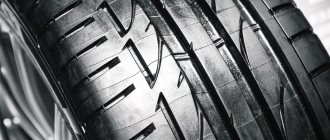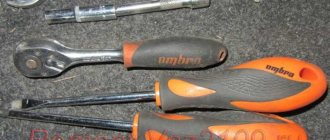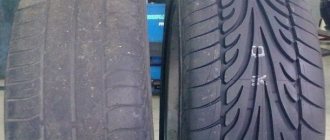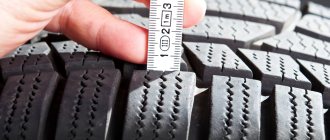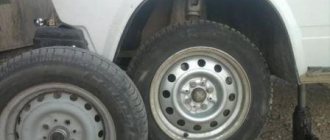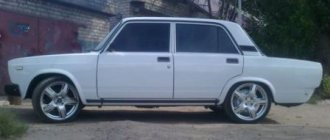The choice of protectors determines the controllability of the vehicle, the duration of its operation, stability and quality of traction. Therefore, before moving on to installation, you need to understand what kind of tires you need to buy, what consequences await you if installed incorrectly, and how not to get into trouble. In the article we will talk about directional tires and look at: what they are, how to install tires correctly, choose rubber with an arrow pattern (and without it) on the tread, we will talk about ways to install wheels with a choice of direction.
Types and their classification
Regardless of the season, there are several types of tires that differ in design and functionality. To understand what type is in front of you, you can evaluate:
- markings on the side;
- tire relief.
It is worth knowing exactly what tires are on your car. This is necessary for personal safety and to save time in the service if you decide to buy a new kit or need emergency assistance. Let's look at each type in detail.
Non-directional tires
Such protectors are considered classic. There is no fundamental difference in how to install the tires (in which direction); they are equally suitable for installation on the front and rear axles.
Recently, symmetrical tires were considered the most common; later, their asymmetrical appearance appeared and gained great popularity. Nowadays, non-directional tires are often included as standard equipment at the factory. The advantages include:
- low cost;
- fairly good off-road performance;
- stability on different types of road surfaces - asphalt, paving stones, country roads;
- excellent behavior at high speed;
- produce little extraneous noise;
- The ease of tire fitting is precisely because there is no need to determine the direction of the tire if there is no arrow; they can be placed on either side.
The main disadvantage of this type is considered to be poor adhesion to wet asphalt and wet soil. Thus, this is an average universal option.
Example of a tread in the photo:
Directional tires
They have a pattern indicating the direction of rotation. The efficiency of such tires will be optimal only if they are installed at the correct course. In the symmetrical version, the stripes are directed from the periphery to the center, and in asymmetrical models they are mirrored. In both cases, there is a marking on the sidewall with the inscription Rotation, which means “rotation” in English.
Advantages:
- excellent contact with the road in any weather - snow, rain, frost;
- reduction in braking distance compared to the previous version;
- an ideal solution for winter driving - accumulations of snow and dirt are collected and discharged along grooves from the center to the periphery;
- simple controllability of the steering wheel, holds the course well and does not deviate from it;
- high speed.
There are also some disadvantages:
- increased noise when driving on dry asphalt, especially with symmetrical furrows;
- the master must know how to correctly position the wheels on the tread, otherwise all the advantages that the pattern has will be lost;
- off-road, the handling advantages are invisible;
- asymmetrically oriented tires are rarely used, because few people want to carry 2 spare tires at once due to their separation into right and left;
- retail price is slightly higher than the non-directional alternative;
- It is not advisable to bead the tire from one side to the other.
Asymmetrical pattern
Due to the lack of symmetry, the protectors self-clean from dirt and water. It is worth paying special attention to two details that you will need to know during installation:
- Outdoor. It is marked Outside. It is responsible for ease of control and lane keeping. There are fewer lamellas and grooves, the pattern is smoother, but the rubber crumb and cord are dense, which provides better grip on the asphalt and an increase in the contact patch.
- Internal. It is marked Inside. This part is responsible for draining water, slush, snow, and dirt. On this side, the tread pattern is brighter, which is necessary for excellent handling and stable cornering.
A significant drawback that experts highlight is the mandatory installation of the tread according to the factory markings. You cannot accidentally confuse the direction or throw the tire from one side to the other. There should even be two reserves - right-hand and left-hand.
But the model has more positive qualities, among them:
- Excellent stability in the strip.
- There is virtually no hydroplaning effect. This occurs when some traction is lost during rain. Due to the deep grooves on the tread, the fluid drainage function works effectively.
- Ideal cornering, even at high speed.
- Shorter braking distance.
- High controllability.
Let's summarize: the presence of stepped grooves on tires with asymmetric tread increases the level of wheel grip. These tires perform best at high speeds on asphalt. These conditions give them the opportunity to demonstrate all their advantages clearly.
Our production
Truck tires
Tires for special equipment
Tires for agricultural machinery
Wheels with a symmetrical pattern: how to install them correctly
Such protectors are suitable for owners of cars of different sizes. Tires are cheaper than asymmetrical ones, but at the same time have a fairly high level of comfort and safety. From the name it is already clear that the inner part of the tread in a mirror image repeats the outer side.
Let's consider the advantages:
- Affordable price.
- Fairly high quality.
- Good handling.
- Very simple tire fitting. It doesn't matter which side the tires are on. Accordingly, the spare tire can fit absolutely any wheel.
The main disadvantage of such tires is that they are not very stable on wet roads.
When we have dealt with the main types of tires, it is important to note one nuance: never put different types of models on a vehicle. Sometimes drivers try to improve ride quality, for example, by mounting an asymmetrical pair on the front wheels and a symmetrical pair on the rear wheels. Know that such actions will only spoil the vehicle’s stable behavior on the road and lead to poor handling.
How to correctly place tires on the left side in the direction of travel
The right- and left-hand position of the tires only matters for asymmetrical models, since their inner and outer parts are not similar to each other and perform different functions. In order not to confuse buyers, modern left-handed tires are marked Left. If it is not there, then on the left will be the tire with the arrow pointing straight, and the inner tread is more rugged, with a plentiful number of grooves.
Tires for right wheels
Their sides should be marked Right. If it is absent, you need to ensure that if the axis is in the correct position, there is a smoother edge on the outside. It may have OUTSIDE engraved on it.
It is very important not to confuse how to correctly place the rubber on the wheels in the direction of the tire tread pattern in asymmetrical models, as this can lead to skidding when turning, as well as poor stability on the road during precipitation.
Types of Tread Patterns
The non-directional symmetrical arrangement of tread blocks is in consistently high demand among motorists who prefer tires in the inexpensive price category. In addition, a large number of new cars have tires of this type as standard. The popularity of this type of tread is explained by the fact that this pattern is considered universal. Advantages of tires with tread blocks placed in a symmetrical, non-directional pattern:
- do not create unnecessary noise while the vehicle is moving;
- allow you to comfortably drive the car at low and fairly high speeds;
- They are distinguished by moderate cost, combined with fairly high-quality performance.
The absence of restrictions in the direction of rotation is an additional advantage of such tires. Thanks to this, during the installation process you don’t have to worry about the rubber being installed on the wrong side. A vehicle with such treads on its wheels will be well controlled when driving on dry or slightly wet asphalt surfaces or on hard dirt surfaces.
When driving a vehicle with symmetrical non-directional tread, be careful when driving on wet roads.
The symmetrical directional pattern of the tread blocks was designed to make the movement of vehicles on wet roads as comfortable and safe as possible. Increased resistance to aquaplaning is achieved due to the presence of drainage grooves arranged in a herringbone shape. Tires with this tread pattern must be installed on the wheels with special care. An incorrectly installed tire will not rotate in the intended direction, as a result of which the rubber will not be able to fully demonstrate its positive driving qualities. Correctly mounting tires with symmetrical directional tread is quite simple, because... There are special inscriptions on their sides that make it easy to distinguish the outer side from the inner side. It should be noted that good directional stability at high speeds can only be achieved on an asphalt surface. Dirt roads quickly clog the tread pattern, exposing your vehicle to dangers such as sliding or skidding.
Tires with asymmetric tread blocks are leaders in vehicle handling tests. Their distinctive feature is the division of the tread pattern into internal and external parts. The inner tread blocks are designed to interact with wet road surfaces, while the outer blocks are designed for dry and unstable road surfaces. Thanks to this solution, tires with asymmetric tread outperform competitors in many technical characteristics
An asymmetrical pattern can be either directional or non-directional, with non-directional being much more common. When installing tires with an asymmetrically located tread, you must pay attention to the markings that allow you to distinguish the inside from the outside, and install the tires correctly
It’s not often that you come across tires that have both a directional and asymmetrical pattern at the same time. The advantage of such rubber is the combination of the above-described qualities of directional and asymmetric treads. Installation of such tires is carried out taking into account the markings applied by the manufacturer.
An unexpected situation may occur on the road, as a result of which you will have to continue your journey with an incorrectly installed wheel. In this case, the speed limit should not exceed 70 - 80 km/h, and the tires should be replaced as soon as possible.
Seasonality of tires and rules for their installation
First of all, let's look at the markings. The side of the tire may have the following symbols:
- “M+S” or “M&S” - this does not indicate the season and usually means that such vehicles can be used off-road, mud, and slush. The tread has very deep grooves that help drain away contaminants.
- If it says WATER, RAID, AQUA, then this tread has very good grip on wet surfaces.
- For winter options it's even easier. They have a snowflake or the English word Winter on the sidewall.
- You can read All SEASON, ROAD+WINTER or ANY Weather on all-season.
The seasonal setting is no different from the general rules. Carefully look at the direction of the arrow, and if there is none, at the location of the grooves.
Design Features
The structural features of rubber are distinctive features that increase the driving characteristics of the vehicle. It is important to understand them in order to choose the right replacement tires.
Tubeless, in case of a puncture they retain elasticity for a long time. The rubber tightens around the stuck object. Does not overheat when moving, due to heat removal by the open (metal) part of the rim. In contrast to the tube type, there are increased requirements for the rims, the need to apply additional sealant at the junction of the rim and rubber, and the complexity of installation. Tubeless ones are used more often; if mounted correctly, they have high wear resistance.
The difference between bias-ply and radial tires can only be correctly determined by the markings. Radial - r. Diagonal - do not have a letter index. You can understand the markings of diagonal ones by the presence of the TT designation - operation with a camera. Those who value speed need to understand the differences.
Consequences of improper tire installation
In case of poor quality work, installation errors, inappropriate protector sizes and non-compliance with the rules, you will notice:
- aquaplaning of a car on wet surfaces;
- not very good car handling;
- less contact with the road;
- uneven tire wear;
- increase in braking distance;
- acceleration duration.
Types of asymmetric tires
Typically, the tread of asymmetrical tires is divided into two halves, each of which has its own “pattern”, as well as structure - one side can consist of multi-directional blocks, and the other has a V-shaped direction of rotation. Asymmetry also comes in two types: directed and non-directional.
- The non-directional asymmetrical pattern, due to its special design, significantly improves contact with the track, especially under heavy loads and high speeds. Thanks to it, tires resist deformation well when cornering and sharp lane changes, and also hold their course more stably. It is perfect for high-speed driving, when good handling and lateral stability are vital.
- Models with a directional asymmetrical pattern have their own direction of rotation, and therefore they must be installed according to the markings (see below for more information on this). This is an extremely rare type of pattern that combines the advantages of directional and asymmetrical design.
In other words, there are a lot of options for asymmetrical patterns, and it is quite difficult to unambiguously classify them. Tires with an asymmetrical tread pattern are somewhat less common than other options, but their popularity is only growing every year, despite the higher price due to the complicated production process. The last point is the main disadvantage of asymmetric tires.
Recommendations for installing directional tires
If you decide to install it yourself, look for the inscription ROTATION on the sides of the tread, that is, “rotation”. There is usually an arrow next to it. It is very easy to install tires along the specified vector.
If you do not find such markings, you can take a different route. The peculiarity of directional wheels is that the pattern on the tires is arranged in a herringbone or wedge pattern. The top-acute corner of the pattern should be directed forward in movement.
Here are some more tips:
- even after contacting a car repair shop, be sure to check the compliance of the markings yourself;
- after reloading, do not forget to go for balancing or do it yourself;
- Another mandatory check is air pressure.
Types of car tires
There are several types of tires, regardless of the design features of the cars on which they are used.
- Asymmetrical tires . The outer and inner parts of the rubber differ in tread pattern. Such tires can be identified by the inscriptions: “Side Facing Inwards”, “Facing Out”, “Inside”, “Outside”. To install the tires correctly, you must follow these marks.
- Symmetrical tires . This rubber has a tread pattern, as well as the design of the sidewalls and cord, which are symmetrical on both sides. Therefore, they can be installed on disks without position control.
- Directional tires . Products that have a structurally determined direction of rotation. “Working” of the rubber in the opposite direction is not allowed. Typically, the sidewalls indicate “Rotation” and an arrow in the correct direction.
- Left and right tires . Such wheels require strict installation according to existing instructions. Tires marked Right on the sidewall should be installed on the right, Left - only on the left. If there is no such inscription on the tires, then this requirement does not need to be observed.
Since the concepts described above are not mutually exclusive, there are situations when the rubber is marked with several requirements at once. For example, there may be directional asymmetric wheels. Nokian had asymmetrical right and left tires in its line.
Currently, no manufacturer produces asymmetric tires with a given direction of rotation. Practice has shown that dividing tires into left and right does not improve performance. But at the same time it complicates production and logistics.
How to correctly install tires on a rim according to the marks
When buying tires, many drivers pay attention to the multi-colored markings on the sidewalls. The paint wears off quickly in the first weeks of use, but it can help with tire fitting. What color is it and what does it mean:
- Yellow. It indicates the easiest place, usually located opposite the air injection nipple valve. This simple mark makes the balancing system easier.
- Red. This, on the contrary, is the hardest point of the wheel. It should be where "L" is indicated on the disk.
- White. This is the most flexible part. The designation is necessary for car manufacturers and assemblers.
All tire fitters are familiar with the different color markings and can help you decipher them.
Rotation
Tire rotation direction
Some tires (for example, Bridgestone) can be swapped. This is done only crosswise. This means that it is possible to drive 45-60 thousand kilometers, and after that change the location of the wheels. It is possible to put a front left one in place of the right rear one, and a front right one in place of the left rear one. This can be done with the front wheels, but in a strictly defined order.
If the direction of tire movement is specified, the wheels are rearranged on one side, i.e. Front tires are swapped for rear tires and vice versa.
When the tires are symmetrical, it is possible to change the arrangement in any order.
How to set the “winter” correctly
In Russia, at the legislative level (TR TS 018/2011), the need to replace the summer set of tires with winter ones is established with the onset of cold weather. Their main differences are the quality of the rubber mixture and the presence of studs. This allows for increased stability on snow and ice. You should “change your shoes” in advance, at the first frost, or even better – a week before them. According to traffic rules, driving in the “winter” is prohibited in June, July and August, and the use of summer tires is prohibited in the winter months.
When contacting a tire shop, pay attention to:
- Inspecting the sidewalls for cuts, cracks or foreign objects.
- Determining the direction of the tires - “herringbone” forward. If you break this rule, you may completely lose control on a snowy road.
- Checking the stable position of the studs. They shouldn't fall out. To check this, run it at low speed.
- Stand alignment and balancing.
Introduction
Models with asymmetric tread patterns are becoming more common. It looks quite stylish and aggressive. Does this design have a useful meaning or is it just another marketing ploy? In the article we will find out what an asymmetrical tread pattern means, analyze its useful qualities, and also tell you how to install such tires on a car.
Is it possible to install tires with different treads?
Sometimes car owners are more concerned about savings than safety and buy only 1 tire instead of replacing the entire set. As a result, the car sits on tires with different patterns. But already in the traffic rules it is noted that it is strictly forbidden to put wheels with different patterns on the same axle (front or rear). According to car enthusiasts, sometimes this is acceptable.
But this is definitely a bad idea because:
- The sipes and grooves are different, and the braking characteristics (speed and braking distance) are also significantly different. In an emergency stop, this can cause a skid and lead to an accident.
- Road grip and hydroplaning will also vary, which is very dangerous when driving fast.
- The treads wear unevenly, as rubber compounds of different quality are used.
- All tests and, accordingly, indicators declared by world-famous manufacturers are based on compliance with the condition of a complete set of tires.
Remaining tire tread depth
Car tires that have a certain mileage have an important value (technical characteristic) called the remaining tread depth. It is easy to guess that it shows the degree of tire wear and indicates the possibility of further use. In the absence of special tire wear indicators, the residual height (depth) of the tread pattern should not be lower than the following permissible values:
- for motorcycles (category L) – 0.8 mm;
- for trucks and trailers (categories O3, O4, N2, N3) – 1 mm;
- for cars and trailers, as well as vehicles with a maximum weight of up to 3.5 tons (categories O1, O2, M1, N1) – 1.6 mm;
- for buses (number of seats more than 8, categories M2, M3) – 2 mm.
The residual depth for winter tires with different tread patterns when used on certain types of road surfaces should be no more than
4 mm. These tires are designed for driving on snowy and icy roads. They are marked with large Latin letters “M” and “S”, and also have a drawing of a mountain peak with a snowflake located inside.
Permissible tread depth for winter tires
Increased demands are placed on winter tires (unlike summer tires, since the quality and height of the tread pattern determines the quality of ride, braking on snowy or icy roads, as well as the safety of the driver and crew members).
The new winter tire has deeper grooves and sipes on the tread, which ensures maximum grip on the road surface and removal of slush from the contact patch. There are three types of tires for driving in the cold season:
- studded;
- friction;
- "Scandinavian".
The first type of winter tires is designed for driving on ice and snow. The studs on the tire break them up, thereby providing good grip on the road surface.
Please note that when passing through asphalt areas, a fairly large background noise is created. It is not recommended to brake sharply, as this can deform the rubber and damage the studs.
Friction tires are designed for driving on slush, mud and shallow snow. Compared to summer tires, the tread height of winter tires should be at least 3 mm higher. Friction rubber has a large number of narrow slots, as well as specially shaped lugs, which significantly increase the stability of the machine on wet road surfaces. All tires of this type are required to be equipped with a symmetrical pattern.
As for “Scandinavian” tires, this type of tire is designed for driving in sub-zero temperatures and heavy snowfall. The tread depth of such tires must be at least 8 mm. “Scandinavian” tires are equipped with an asymmetrical pattern, where wide cups with lamellas are clearly visible, which are necessary for effective action on snow and ice, as well as their removal from the contact area.
Permissible tread depth for summer tires
The tread depth of summer tires directly affects the quality of wheel adhesion to the road surface and promotes water drainage from the contact zone, so its size ranges from 6-8 mm
Please note that the acceptable wear level should not be less than half the original tread height. The minimum tread depth at which tires are allowed to be used must be at least 1.6 mm
In order for summer tires to be used, a prerequisite is the presence of a clearly defined tread pattern, otherwise traction and water drainage will significantly deteriorate (the aquaplaning effect will increase). On new tires, the depth size may vary depending on the type of vehicle. For example, on sports and racing cars, the tire tread height can be 12-17 mm, while on SUVs this figure can be higher.
Replacement procedure: what pattern should you use for the wheels?
Tire fitting algorithm:
- Unscrew the bolts - loosen them a little, but do not remove them completely.
- Raise the car on a jack.
- Secure the body in a suspended position.
- Remove the old tire and install a new one, pre-balanced, taking into account the direction of travel - with the wedges forward.
- Retighten the fasteners.
- Lower the car.
Car owners in most cases prefer to contact a tire service. In addition, other auxiliary procedures can be carried out immediately at the service station, for example, balancing, pumping up air.
Let's find out how to do the installation correctly
Before determining the direction of the tire, it is important to know that the Goodyear tire direction marking for an asymmetric pattern is indicated: LEFT - left; RIGHT - right; outside - external side, inside - internal. install tires on the car according to the pattern on the tread or arrow. If they are symmetrical, follow the symmetrical pattern, its direction should coincide with the direction of movement of the wheel. If you need to install in a direction, the correct designation is ROTATION - rotation.
How to find out the direction if there is no marking - a herringbone pattern? Rotate the tire in both directions - the top of the herringbone should touch the road first. This is the correct way to install a wheel without marking the direction of rotation.
Recently, manufacturers have switched to symmetrical wheels, since it is impossible to know which one will fail. Correct replacement scheme:
- loosen fasteners;
- lift with a jack;
- unscrew the fastener completely;
- remove the tire;
- put on a new one;
- gradually secure the wheel; — do not tighten the fasteners completely;
- lower the jack;
- tighten fasteners.
It is also worth understanding that you cannot use anti-corrosion agents on the road to treat fasteners - imbalance. You can recognize the accuracy of balancing by the absence of knocking. The same method can be used to determine the correct installation.
Correct installation is impossible without balancing the rotation on a special machine. It is impossible to install a tire without a tube without the appropriate equipment. It is important to understand that you cannot install tires from different manufacturers on one vehicle - non-uniform depreciation is the result of suspension knocking. You shouldn’t skimp on load-carrying capacity and elasticity; replacing the chassis will cost more.
Replacement scheme
Previously, it was believed that wheels had to be installed in a certain order. That is, during the season there should be one arrangement, and at the next “change of shoes” - another. All this had one goal - to ensure uniform wear on all elements of the kit. Now this remains relevant only for non-directional asymmetrical models, which can be placed in any way. Let's look at an image with an approximate shift diagram:
Please note: with correct wheel alignment, tire wear will occur evenly, and the indicated diagram will not be useful to you.
How to change a tire on a car yourself?
How to change a tire? For the majority of the male population, this question is so simple that it is not even discussed. But what if you damage a tire while traveling and there is no man nearby? You can call technical assistance, or still try to solve the problem without the help of others. Let's find out in practice whether it is difficult to change a tire with gentle women's hands?
It turned out to be completely easy. You don't need to put in a lot of effort to lift the machine. There is also no need to carry wheels. The most difficult thing on some cars is to find a jack and a set of tools. Dear car ladies, we bring to your attention a step-by-step summary of how to change a tire.
To replace a damaged wheel we will need:
- Wheel chocks or a pair of bricks;
- Jack;
- Wheel key;
- Piece of pipe;
- Gloves;
- Some clothes to avoid getting dirty;
- Spare wheel.
Wheel installation direction Sava pattern
Mark Sava is from Slovakia. Directional and equilateral tire models that are in demand in Europe are produced here. The brand's products are popular due to their good combination of price and quality.
Regarding the direction of the drawing, it all depends on the type of model and intended application. The model range includes varieties of all designs.
Directional slopes are installed according to the arrows, asymmetrical ones are installed according to the inscriptions Outside and Inside.
How a properly installed tire with directional tread reduces hydroplaning
Here you can talk and explain for a long time. But it’s better, as they say, to see once. We made a GIF especially for you. Take a look.
Essentially, the tread works like the blades on a centrifugal pump as it pumps water, except that the driving force here is not centrifugal force, but the force from squeezing water into the tread grooves. Force occurs every time the tire hits the slurry it is supposed to push out. So water, dirt, and wet snow are squeezed into the groove and discharged out. The wheel rotates further, and new water is again squeezed into the groove as the car moves. Due to the removal of such “lubricant”, the contact between the tire and the road improves, which entails a safer ride. Everything is so simple and logical. Here I would like to talk about the direction of the drawing. As we have already said, you can pay attention to the “ROTATION” marking, or you can look at the drawing.
(tire installed correctly)
So, the tread grooves should always move away from the contact patch of the tire with the road towards the rear of the car, if you look at the wheels on the left from above. And the opposite situation for the wheels on the right. In this case, you don’t have to look for the markings on the rim. Looked at the tread pattern and put a tire on the car according to the pattern.
What is special about the directional tread design?
There are four types of car tire tread pattern:
- directional symmetrical,
- non-directional symmetrical,
- non-directional asymmetrical,
- directional asymmetric.
Each drawing is created for its own version of the road and has its own set of advantages. Different tread patterns have different functionality and behavior on the road. When mounting tires on rims, there are also installation principles that must be followed strictly so as not to create an emergency situation. We will talk about them in the appropriate section. The essence of the directional design of the tread zone is clear at first glance: the blocks, ribs and drainage grooves of the V-shaped “pattern” have a directional shape, twisting the wheel in a certain direction. Most often, directional tires are found on winter models, but there are also many of them among summer ones. In symmetrical tires, both halves of the directional tread are mirrored; in asymmetrical tires, both halves have a different structure and different functionality. It is necessary to mount the wheels only in the right direction, otherwise all the advantages will come to naught, and at the same time problems with handling and accelerated wear will be added. Excessive pressure will accumulate in the center of the working area, which is why the tire will begin to rise above the road and harm traction in many areas.
In which direction should you install Continental tires?
The products of the German corporation are in great demand among Russian buyers. The manufacturer's product range includes asymmetrical and directional designs. According to European standards, in 100% of cases there are indicator elements on the tire that facilitate correct installation.
All the inscriptions and arrows present will help you to trim the ramp as accurately as possible.
When is it necessary to replace wheels?
If the tread is clearly wearing away very quickly in one stripe, rotating the wheels will help even out the wear, but will not solve the problem.
“Narrow” tread wear occurs most often due to an incorrect camber/toe adjustment angle. The wheel is simply very inclined and is in contact with the road not with the entire plane, but with one narrow strip. In such cases, together with or instead of rearranging, it is recommended to correctly adjust the camber/toe angles.
Sometimes such accelerated wear may be due to suspension wear, which also requires diagnosis and elimination of failed suspension elements.
What happens if you install it incorrectly?
No extra words are needed here. Excessive pressure will build up in the center of the tire. Accordingly, it will rise above the road, which is unsafe. The grip of the car will decrease and there will be a risk of the vehicle tipping over on its side. And the wheel hub risks coming off. And this is already creating an emergency situation on the road.
How to swap wheels for even wear
Regular rearrangement of wheels according to different patterns (front - back, left - right and vice versa) can increase the service life of tires by 1.5-2 times, sometimes more. If the tires are worn out on one side and on the inside on the other, they need to be swapped.
This is an example of obvious wear visible to the naked eye, and the logic behind the replacement order is obvious. If nothing is done, the tires can quickly wear out, some on the inside, others on the outside or in the middle. Timely rotation of wheels will ensure even wear and will undoubtedly extend the life of the tires.
Which direction should you install Yokohama Ice Guard tires?
Old versions of Ekohama Ice Guard tires had a symmetrical, directional tread type, where it was almost impossible to confuse the place or side of installation.
In 2022, the manufacturer introduced a new generation of the model to the Russian market. The asymmetry of the shape of the working area is clearly visible here. Due to the design change, new markings appeared on the tire. Internal and external honor indicators are located on the sidewalls, where “Outside” is the outer side.
Is it possible to swap wheels with pressure sensors?
In most cases, pressure sensors immediately or after 2-3 km of run restore communication (are registered) automatically with any rotation of the wheels. Otherwise, problems would also arise during seasonal replacement of tires, which would become a problem for the owners and reputation of a particular brand.
From experience, sometimes it is necessary to inflate rearranged wheels to increased pressure values - 2.3-2.6, and then lower them to normal in order to restore the operation of the sensors.
In all cases, the most accurate recommendations are set out in the Operating Instructions for each specific car model.
